31 Days, 31 Lists: 2023 Nonfiction Picture Books

I make this list for me.
So far this month you’ve seen an array of different kinds of nonfiction titles. With this list, however, we embark upon my favorites of the favorites. These are the nonfiction picture books closest to my heart. The ones that I truly feel did their jobs the best. A lot of these you’ll have seen before, but there are a couple new inclusions, simply because they didn’t neatly slot into any other categories. Agree! Disagree! Debate! It’s wide open.
Would you like a PDF of today’s list? You can find one here!
Interested in previous years’ Nonfiction Picture Book titles? Try these:
2023 Nonfiction Picture Books
An American Story by Kwame Alexander, ill. Dare Coulter
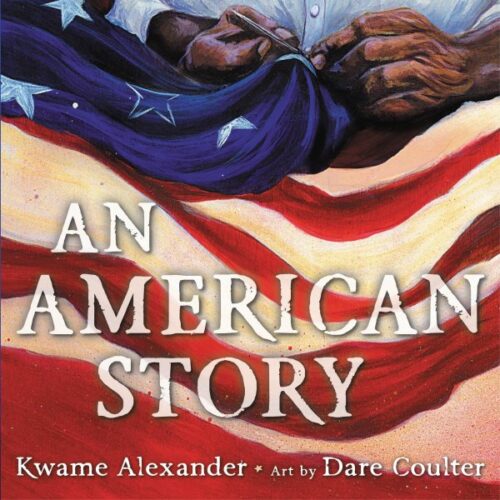
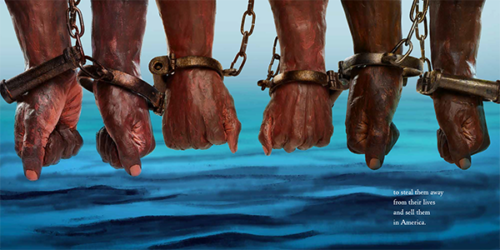

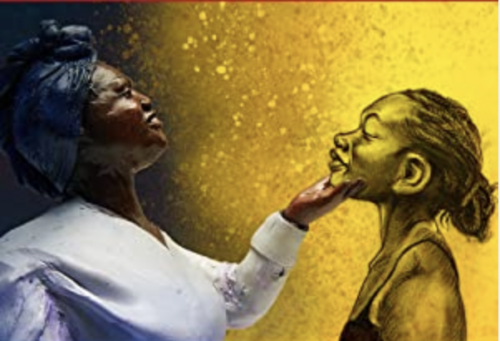
You can’t tell the story of America by just telling the happy parts. A look at early slavery in America and a consideration of what we teach our kids at school. Holy moly! You know, every author, no matter how good they are, has their ups and downs. They simply can’t knock it out of the park every time. So when I pick up a Kwame Alexander book, I don’t care how many starred reviews it has. I want it to surprise me. Well, apparently after working with Kadir Nelson, Kwame must have thought to himself, “Hey, winning a Caldecott Award was fun. I wonder if I can do it again?” because the art of Dare Coulter here is jaw-dropping. Seriously, I’m already mentally writing articles about what it might mean for this to be the first Caldecott Award winner to use modelwork on the page (though, of course, we’ve had Honors like Frida by Yuyi Morales). Inspired by his kid’s school’s egregious teaching of slavery when discussing colonial America, Kwame sets the record straight. The title is on point, but it’s the art of Coulter that blows you away. When you get to that shot of the girls by the fire, that’s when you know you’re in for something amazing. It’s rough but it’s honest. The anti-CRT crowd ain’t gonna like this . . . Previously Seen On: The American History List
ADVERTISEMENT
ADVERTISEMENT
Ancestory: The Mystery and Majesty of Ancient Cave Art by Hannah Salyer
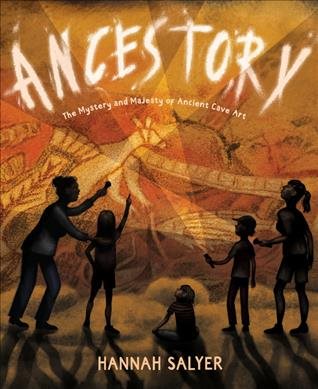
Art by our ancestors exists all over the world, and can say something to us even today. Take a visually beautiful and fascinating deep dive into not just any history, but our history, and what we can do to protect it today. It’s like I’ve been saying all along. The Pleistocene is HOT in 2023. If you’re going to write a book about art created by humans in the ancient past, it is imperative that you do so with grace and consideration for indigenous communities. Figuring out how to do that correctly, in addition to working out the best way to lay out the information in this book, is a tall order, but Salyer is more than up to the challenge. I was deeply impressed not simply by the care with which she presented this material, but for things like double gatefold spreads, typographical changes, and thoughtful art. The fact that people in the past are not depicted clearly, but as outlines and shapes is key to this book’s success. The Site Map at the end of art found around the world should be turned into a poster that people can frame. Additional points for getting into not simply visual but audible art of the past. I have never ever seen anyone account for that before. Beautifully sourced and respectfully done.
Beautiful Noise: The Music of John Cage by Lisa Rogers, ill. Il Sung Na
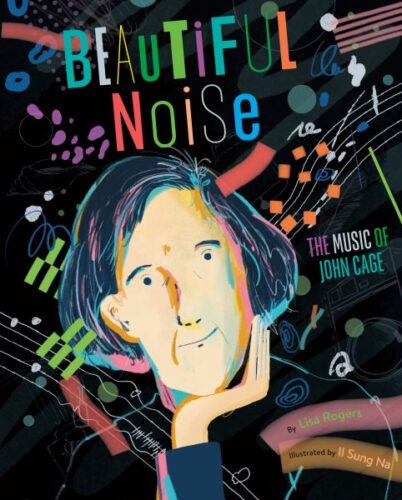
Boy, it sure does make a difference what illustrator is paired with a given book at a given time. I’m not saying that writer Lisa Rogers hasn’t done a stand up and cheer job here. She has! I’m just saying that if these words had been paired with so-so art, I’m not so sure the final product would be anything to write home about. Fortunately, a good editor knows when to make the call and hire a great artist. Il Sung Na was always been better known to me personally for his work on The Book of Sleep and such. I’ve never seen him try his hand at a picture book bio, and he does not disappoint. First off, let’s talk endpapers! Using shapes and colors to represent different sounds, you could have an extended conversation with a kid over whether or not “Miffed” or “Murmuring” look the way Na has depicted them here. The book itself is my favorite kind of picture book bio. Which is to say, the kind that doesn’t go the “Such n’ so was born on [blank] to [blank] and when his mother saw him she said [blank]”. Booooring! Instead, Rogers had to think long and hard about what the point of a John Cage picture book bio would have to be. Her answer? How all sound, or even lack thereof, can be music. Do you want to get a clear cut explanation about why Cage wrote a four minute and thirty-three second piece where the pianist didn’t play a single note? It’s a beautiful dual bio of Cage and of Cage’s music equally. The best book to pair this with might actually be The Noisy Paint Box by Barb Rosenstock about Kadinsky. Worth discovering. Previously Seen On: The Biography List
The Bees of Notre Dame by Meghan P. Browne, ill. E.B. Goodale
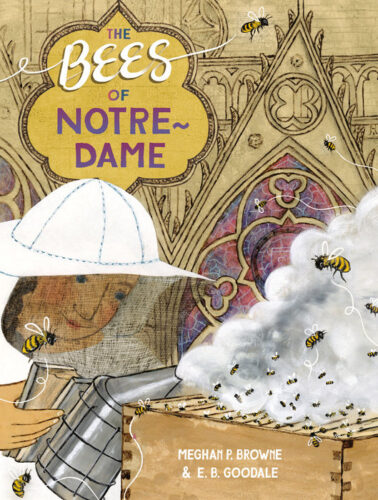
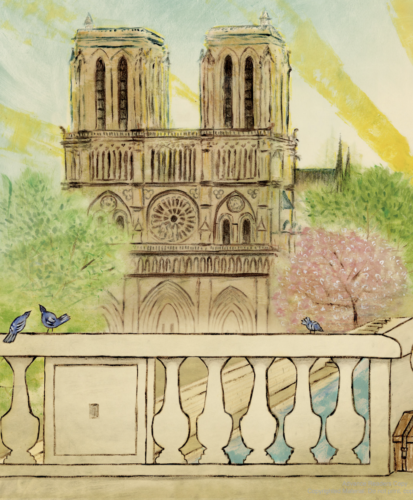
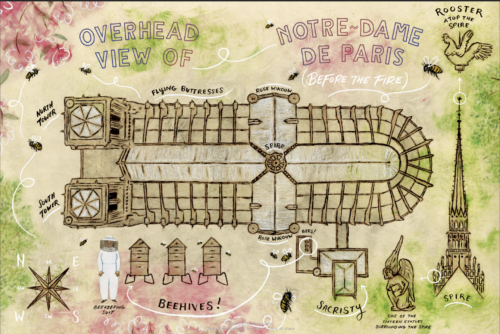
High above the rooftops of Paris, it isn’t Quasimodo on the roofs of Notre Dame, but beekeepers and bees! But when the fire of Notre Dame destroys so much of the cathedral, what will happen to the insects? Though it ends a little abruptly, I think this is just the loveliest look at what is, for me, the second Notre Dame fire book I’ve seen yet. I’m really enjoying how picture book artists that haven’t previously done much nonfiction are making the shift. Goodale’s art is filled with such beauty. The sudden fire really does give the reader a gut-punch. I do wish that the book itself mentioned (rather than just showed) in the text that the bees survived, but check out the front and back endpapers. I love all the little details there. I like books that have original takes on interesting topics, and the team of Browne & Goodale readily falls into that category.
The Book of Turtles by Sy Montgomery, ill. Matt Patterson
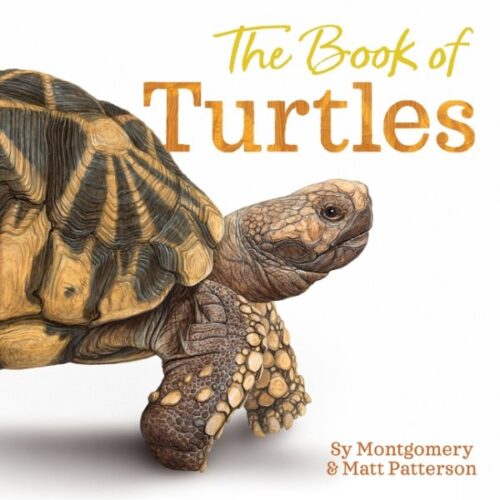
Think you know turtles? Think again! An up-close-and-personal deep dive into a species and all its weird and wonderful qualities. Best. Turtle. Book. Ever. It’s the mark of a great author when they can take a subject that’s been done many times before for kids and reintroduce it in such a way as to make it not just interesting but fascinating. I sort of knew before reading this that a turtle was essentially fused into its shell, but Montgomery gets up close and personal with these creatures, telling you new facts next to old, but remaining consistently interesting throughout. I also knew that some turtles breathed through their butts. I just didn’t know that some peed through their mouths(!!!). Plus the art by Patterson is remarkable. Even if you aren’t a turtle lover, you’re going to be delving deep into this one. Previously Seen On: The Science and Nature List
Butt or Face? by Kari Lavelle

Think you can tell a butt from a face? Test your skills against an array of insects, amphibians, birds and beasts. We bet at least one of them fools you! Normally I don’t get overly fond of titles where the entire premise is right there in the title. But as I read through this cacophony of buttocks and kissers I had to admit that Lavelle knows what she’s doing. There are an awful lot of difficult-to-distinguish butts v. faces. Admittedly she cheats a little, sometimes just showing a section of an animal’s anatomy, but by the point she starts doing it, you really don’t care. I like the design of it too and the way in which the little facts are added along the sides for fun. Maybe not the most deep and insightful book up for consideration, but there is something to be said for fun (plus doesn’t that cover just invoke Everything Everywhere All At Once?). Previously Seen On: The Gross List
Darwin’s Super-Pooping Worm Spectacular by Polly Owen, ill. Gwen Millward
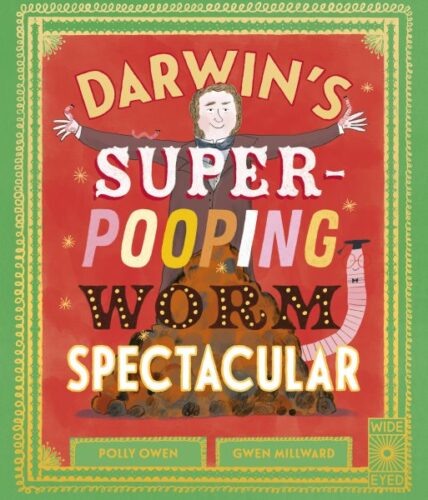
The Victorians were pretty sure that worms weren’t just gross, but utterly useless as well. It took Charles Darwin’s obsessive nature to prove that not only are worms important, but their poop is vital to nature! The most fun you can have with an invertebrate. Man. Polly Owen is toying with me. I’m this hard-nosed stickler for picture book nonfiction, right? I hate fake dialogue. I like my facts to be facts and not suppositions. All that stuff. So she goes and writes a book that is technically all-factual by skirting around the very edge of all my rules. For example, I don’t mind it when dialogue in speech bubbles is fake. Now in this book, Darwin is conducting experiments on the worms. I thought I could safely deem this book Informational Fiction when it showed him playing the piano, fife, and bassoon for the worms. But on the opposite page you actually see this little worm clarifying that, yes indeed, Darwin really did try out all those instruments with his invertebrates. The end result of this is a compelling (and oddly excrement-heavy) bit of good science wrapped in a gross-out package. Gwen Millward is also just going wacky with the art (the bassoon sequence is accompanied by what looks to be a disco floor complete with mirror ball). This is utterly ridiculous and, I’ll admit it, completely within the realm of fact. Kids will dig it (forgive me). Previously Seen On: The Gross List
Desert Queen by Jyoti Rajan Gopal, ill. Svabhu Kohli

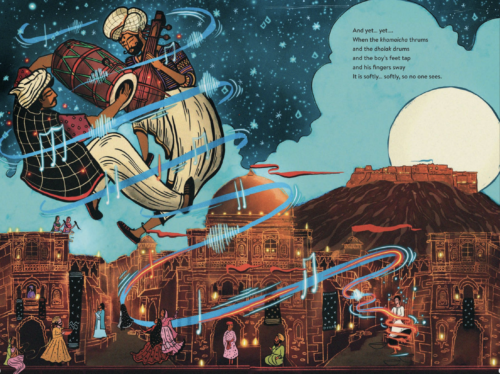
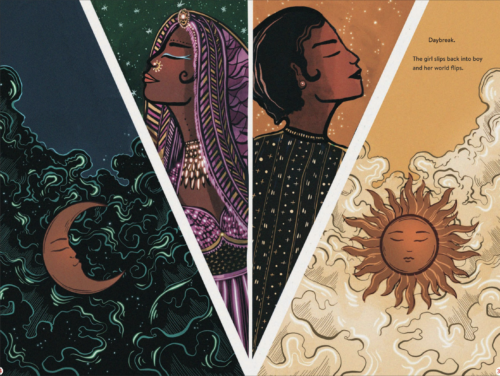
This one’s cool. It’s probably safe to say that this is the first picture book biography on Harish Kumar/Queen Harish to ever come out, and how nice that when it has it’s as beautiful as it is. It’s difficult to know where to begin to tell this story, but Gopal takes a steady hand to the story of how Kumar became the Rajasthani folk dancer and drag performer Queen Harish:
A biography has a number of different ways that it can convey the life of its subject. Here, Gopal eschews a standard this-to-this-to-this methodology, preferring instead to tap into the emotions of the subject. The text is fairly simple and, compared to some picture book bios I’ve seen this year, downright sparse. Kumar’s transformation into Queen Harish is also remarkable, thanks in large part to the art by Svabhu Kohli. When the text reads, “The boy is shiny and glittery and NEW” that just feels like the mildest description for the art on the opposite page. There, Queen Harish is emerging from a universe in the shape of a man splitting down the center, great lines of light weaving around her, and a new universe forming. And when she dances? Remarkable. Would I have liked a little more backmatter? Heck yes. Always. But there’s an author’s note there with further information on Kumar, so at least we’re not left hanging entirely. The most beautiful drag picture book bio I’ve ever had the chance to see.
And yes. When I read this title I do get “Dancing Queen” stuck in my head. *sigh* Previously Seen On: The Biography List
Dogs: A History of Our Best Friends by Lita Judge

Take a trip back in time to 50,000 years ago and follow the path of humanity’s best friend. From cleaning infectious wounds to clearing birds off of runways, this fact-filled readaloud is a perfect paean to one of our favorite animals. I’ll just throw in the usual caveats. If you know me then you know that I’m completely dog book neutral. Don’t love ‘em. Don’t hate ‘em. Just sorta take ‘em on a case-by-case basis. And this particular case? Probably Lita Judge’s strongest book in years and years. She’s outdone herself here. Like a weirdly large amount of books this year it begins, you guessed it, in the Pleistocene and then goes from there. But the way in which the information is laid out (with longer sections for older dog lovers and shorter sections for reading aloud) is impressive. Plus, I always love it when I learn something from a book. This one taught me that a dog is the only animal that will follow a human’s gaze. Who knew? Previously Seen On: The Science and Nature List
Emperor of the Ice: How a Changing Climate Affects a Penguin Colony by Nicola Davies, ill. Catherine Rayner

Dang. This is a pretty book. A pretty book and a bit of a departure for Kate Greenaway Medalist Catherine Rayner too. I don’t know that I’ve ever seen her tackle nonfiction before but she does a heckuva gorgeous job rendering the Arctic environment in all its harsh beauty. Now, I know you’ve seen penguin books before. Quite frankly, you may feel a little penguined out. Folks, I’m here to tell you that you have room in that cranium for at least one more penguin book and that penguin book is THIS penguin book. Do you remember how Candace Fleming made us care about bees in a way we’d never cared before in her book Honeybee? This is the Honeybee of penguins. Davies does a brilliant job of putting emotion into the book without cheating or overdoing it. Meantime, Rayner’s watercolors are sumptuous. There’s a particular shot I’m thinking of where you see the line of penguins silhouetted against a blood red sky, and it took all my willpower not to rip out of the book and frame on my wall. A stunner (and there’s even some backmatter to boot!). Previously Seen On: The Science and Nature List
The Fire of Stars: The Life and Brilliance of the Woman Who Discovered What Stars Are Made Of by Kirsten W. Larson, ill. Katherine Roy
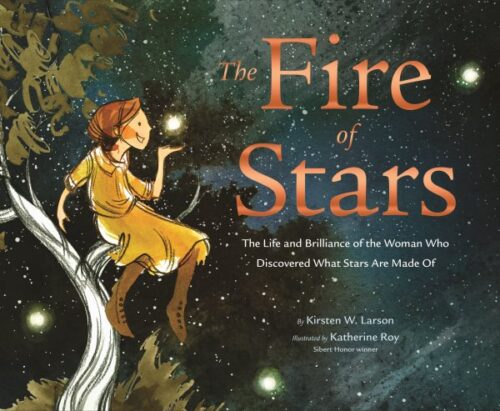

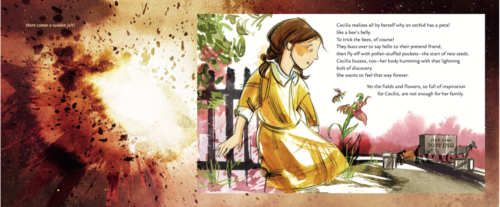
What burns at the heart of a star? The story of Cecilia Payne, ground-breaking scientist, is brought to life in this scintillating picture biography riddled with the mysteries of the universe. In spite of the fact that the subtitle of this book ends with a preposition and completely fails to name its biographical subject on the cover (the longer I look at it, the weirder it gets) this is a stand up and cheer example of how you can take a biographical subject and eschew the rote categorization of their life when you write a book about them. While most picture bios of female astronomers do a dull play-by-play of their life. Larson shakes things up by pairing Cecilia Payne’s discoveries alongside the birth of a star. She has Katherine Roy, science illustrator extraordinaire, there to help her. If you want to have some fun, play attention to how the star information slowly consumes everything behind Cecilia’s biographical history. Also look at how Roy plays with the color yellow in Cecilia’s clothing. No fake dialogue, a surprising story, and great backmatter. Better, by far, than a good chunk of what’s already out there. Previously Seen On: The Biography List
Fungi Grow by Maria Gianferrari, ill. Diana Sudyka
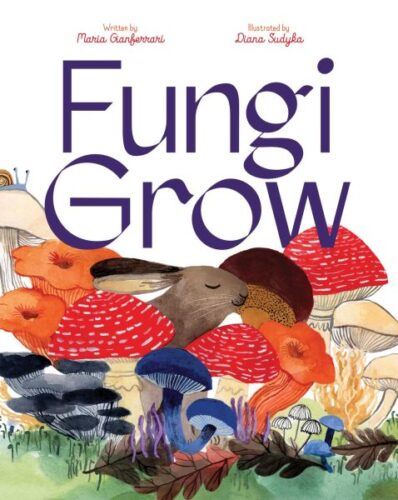
Delve deep into the mysterious world of fungi and all their amazing applications. Their gripping story is paired with the sumptuous, jewel-like watercolors of Evanston artist Diana Sudyka! We’ve seen so many books that talk about tree communication from the trees’ p.o.v. but so few from that of the fungi. This feels like a natural companion to Elise Gravel’s The Mushroom Fan Club, albeit with the beautiful watercolors of Ms. Sudyka. It took me a little while to get into this one since I felt that a lot of the early simple text leans a little too heavily on the more complex small older text portions, but as it continued I thought it really picked up. I was also swayed by all the amazing sections on fungi that can devour plastics and oil. This is a very cool book. Previously Seen On: The Science and Nature List
The Gentle Genius of Trees by Philip Bunting

Trees give us so much here on earth but how much do we know about them? Take an irreverent trip into their communication, likes, dislikes, and more. Not the only Phil Bunting book on today’s list, by the way! So I know I was all gaga about a lovely tree-talking book last year (Listen to the Language of the Trees by Tera Kelley, illustrated by Marie Hermansson). Well, that was close to what I was hoping for in a book, but this sort of clinches it. It really makes tree communication a lot more visually clear and clean. Plus the humor just makes it entirely my bag (a tree overreacting to the message that its leaves might be eaten by screaming, “I’m too beautiful to die!”). I sort of adore this. Previously Seen On: Science and Nature Books
Glitter Everywhere! Where It Came From, Where It’s Found, and Where It’s Going by Chris Barton, ill. Chaaya Prabhat
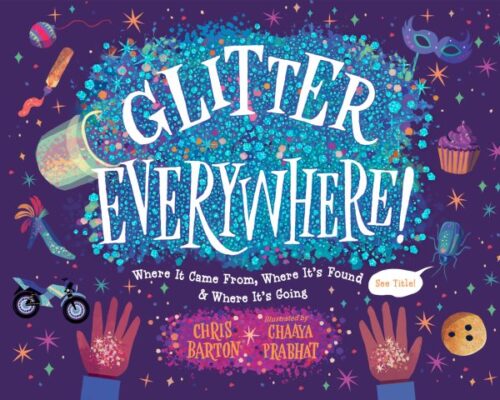
Do you love glitter? Hate it? Then this book is for you! Find out its history, its science, its importance, and what we can do to be more responsible with it so it won’t hurt the environment. If I had the power, I would possibly declare Chris Barton, right here and now, to be the official arbitrator on what does or does not make a conscientious nonfiction picture book. I’ve railed in the past against nonfiction books for kids that skimp on the research, to say nothing of showing their work, but finding examples of the BEST kinds of nonfiction books can be hard. This, however, may fit the bill. In this book Chris doesn’t just give you a rundown of the history of glitter and its problems today, but lets kids in on his research as he goes. When he calls someone by their first names vs. their full names, you find out why. If he can’t find enough evidence to back up a claim, he makes a note of it. He works in science and environmentalism, history and how it relates to Drag performers, and even a bit of math as well. There’s even a note on the front bookflap that reads, “Spoiler alert! Traditional glitter is bad for the planet. That’s why the jacket of this book uses a glitter lookalike.” I’m just blown away. A seemingly silly subject yields one of the best books of the year. Previously Seen On: The Science and Nature List
The Green Piano: How Little Me Found Music by Roberta Flack with Tonya Bolden, ill. Hayden Goodman
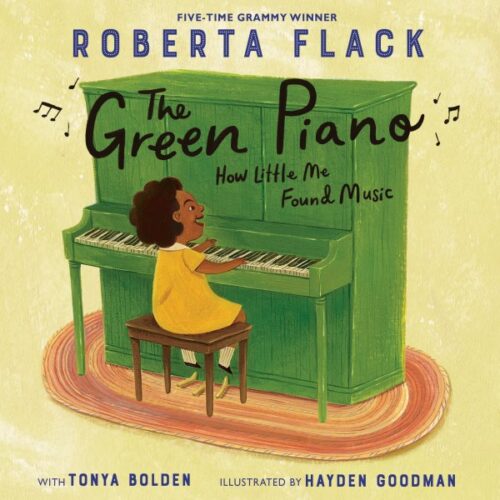
A five-time Grammy Award winner tells the story of how she came to love music and how her family got its very first piano. Loads of personality and fun infuse this delightful tale. Oh, I liked this! I was really worried at the start because initially I missed the fact that Ms. Flack was the actual author of the book. As a result I started getting really huffy about the fact that it was written in the first person. Shows what I know. Here, Roberta’s voice comes through with so much zip and pizzaz and pop! Plus the nerd in me just got really excited watching her dad fix up that old piano. A picture book bio that actually feels like kids would enjoy reading it. Fun! Previously Seen On: The Biography List
The High Line: A Park to Look Up to by Victoria Tentler-Krylov

A park in a sky! Sounds crazy, no? But the High Line in NYC is precisely that. See how it came to be, what it’s inspired, and what its future may hold. I may have to recuse myself when it comes to this book since I lived in New York during the early days of the High Line park, and remember many of the details from the time. This isn’t, I believe, the first High Line picture book title we’ve seen, but it is undoubtedly the best. It does its history, sure, but then it goes on beyond that. It discusses other urban park projects inspired by the High Line’s success. And critically, it talks about the problems with the High Line and how it has adversely affected some of the people living alongside its route, which isn’t something you’d see in a lot books of this sort. The watercolors are, for the record, enticing, accurate, and very beautiful. Love the maps, love the backmatter, the Time Line, and really the whole production. You can sometimes tell when a book is a labor of love. This one clearly was. Previously Seen On: The Science and Nature List
Holding Her Own: The Exceptional Life of Jackie Ormes by Traci N. Todd, ill. Shannon Wright

The life of reporter, cartoonist, dollmaker, artist Jackie Ormes is brought to rip-roaring life in this fun and fantastic biography. Learn as much as you can about the first Black woman to become a nationally syndicated cartoonist! This is a unicorn! A picture book biography about a funny Black woman who broke into the comic strip business. My husband’s a real comics history guy so when I asked him about Jackie Ormes he knew who she was but was unaware of how much she did. Sure, he’d heard about her Torchy series but not her Patty-Jo. The book’s written with a lot of humor and then Traci N. Todd (possibly best known to us for illustrating Varian Johnson’s graphic novel Twins) just goes above and beyond the call of duty to make the art as interesting as possible. My favorite two-page spread is the Family Circus-esque look at her travels as a reporter. This is top notch, original, and worthy of its subject. No small feat. Previously Seen On: The Biography List
The Indestructible Tom Crean: Heroic Explorer of the Antarctic by Jennifer Thermes

Sail with explorer Tom Crean on the ships Discovery, Terra Nova, and Endurance and watch as the man not only manages to stay alive but also saves the lives of his fellow crewmen time and time again. A gripping, wonderful look at a heroic man. First up, I’d like to mention how much nicer it is to read books about Antarctic exploration than Arctic exploration, since at least on Antarctica they didn’t have any native populations to exploit. This is a gutsy, gripping story of a regular guy who just happened to have exactly what was needed to survive over and over and over in impossible situations. It’s nutty to think how he just kept on going back to that frozen wasteland. It doesn’t shy away from the less pleasant stuff (like the fate of his dogs on one of the trips) and reading about that last trip to try and save Shackleton’s crew had me on the edge of my seat. Thermes did a book about Manhattan a year or two ago that I liked (Manhattan: Mapping the Story of an Island) but honestly, I like this one far more. You’ve gotta see it for yourself. Previously Seen On: The Biography List
Jumper: A Day in the Life of a Backyard Jumping Spider by Jessica Lanan

What’s it like to be a spider in the grass? Enter the world of a jumping spider and experience the danger and excitement happening just under your nose. Does anyone remember the picture book The Lost Package that came out a year or two ago? I was just so taken with Jessica Lanan’s watercolors there. Of course, she’d been doing nonfiction for a while anyway (Just Right: Searching for the Goldilocks Planet was great too) but I truly feel that Jumper is a standout in the field. First up, some spider identification backmatter, to say nothing of the Glossary and Resources and general info on spiders themselves. I love how she’s laid out the story so that you get that spider’s eye view through the lens of how it moves, feels, jumps, hears (I always wondered how they heard without ears), and (most gloriously of all) sees. There’s a pull-out double fold spread in this puppy that will blow you away. If I had my way, this would be a Caldecott winner. Fantastic. And you haven’t see what a book looks like under its cover until you’ve seen this Tiktok video by Ms. Lanan. Previously Seen On: The Science and Nature List
Make Way: The Story of Robert McCloskey, Nancy Schön, and Some Very Famous Ducklings by Angela Burke Kunkel, ill. Claire Keane

One man created a story of ducks that became a picture book classic. One woman created sculptures from the book that became beloved Boston icons. But how the two came to be? That’s the story you haven’t heard. Color me impressed. Last year we saw a picture book bio of McCloskey and his creation of Make Way for Ducklings and it was just that. A kind of cute story behind a story. Angela Burke Kunkel takes a different and (quite frankly) smarter approach. She pairs McCloskey alongside artist Nancy Schön and then the two of them come together in an honestly tense scene near the end. Claire Keane’s always had such a great style to her art, but this is the first time I’ve seen the text match her illustrations. I loved her waterlogged McCloskey and the vibrancy she gives these characters. No fake dialogue. Lots of good backmatter. And best of all it’s a picture book dual biography that I honestly think a kid would want to hear again and again. That’s rare! Previously Seen On: The Biography List
One Tiny Treefrog: A Countdown to Survival by Tony Piedra, ill. Mackenzie Joy

“Ten tiny tadpoles grow in their eggs.” Count down as each tadpole falls prey to hungry nature in this eye-opening look at not just treefrogs but survival of the fittest as well. Nature red in tooth and claw, indeed. This book effectively combines two of my favorite things: picture books in which the protagonist gets eaten and nonfiction titles that show nature being nature. And while I wouldn’t want to necessarily read a book that discusses how mama hamsters sometimes eat their own young, this book about a rapidly diminishing number of baby treefrog tadpoles explains quite efficiently why it is that a great number of animals in the world create as many babies as possible. You really don’t actually see any of these froglets die (though there is one moment that comes close) and I love the surprise ending. I wouldn’t give it to one of the more tenderhearted children out there, but I love the backmatter, and animals included, and the way in which it chooses to convey its material. Previously Seen On: The Science and Nature List
A Shell Is Cozy by Dianna Hutts Aston, ill. Sylvia Long
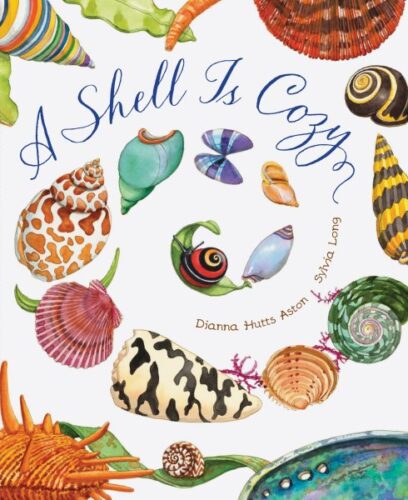
You know, if a format works, it makes a lot of sense to stick with it. I remember way back in 2006 when An Egg Is Quiet by this duo first came out. It was just the nicest little look at. The white background allowed Sylvia Long’s delicate watercolor illustrations the chance to really show all kinds of seeds waking up, doing their thing. Aston & Long followed it up with A Seed Is Sleepy (200&7), A Butterfly Is Patient (2011), A Rock Is Lively (2012), A Nest Is Noisy (2015) and A Beetle is Shy back in 2016 and that, pretty much, was the end of that. Now after a number of years they’ve returned with a look at shells. And doggone it if it isn’t just as good as everything else. Better even, maybe. There are cool interior looks at what the inside of a mollusk’s shell looks like. There are deep vibrant colors and unusual details (love the candy cane snails in the trees). I’d just listened to a podcast about the terrifying poisonous snails, like the marveled cone, that may hold the keys to multiple cures to human diseases, so this fit in well. Long gone are the days when the pages were pure white. Long is having a lot of fun with beautiful sunrises and sunsets, blue seas, and pink skies. I particularly adored the rendition of Watts Towers in L.A. as shown here. It may be part of a series, but this is a true standalone winner. Previously Seen On: The Science and Nature List
Stars of the Night: The Courageous Children of the Czech Kindertransport by Caren Stelson, ill. Selina Alko

When 669 young Jewish people were saved during WWII by a trip from Prague to Britain, they never knew the man behind their rescue. The remarkable story of how they found him fifty years later. Pretty sure I’ve seen a picture book on Nicholas Winston before, but this one does a good strong job with the subject matter, and in an innovative way worth discussing. Stelson has decided to tell the story of the 669 children saved via the Czech Kindertransport from their point of view in a single voice. It’s a bit of a liberty, but I might argue that it’s not overused in any way. In fact, it really puts you in the shoes of these kids quite effectively. Sometimes nonfiction titles struggle to make their stories pertinent to kids. This one doesn’t suffer that problem, and it’s got some good strong backmatter at the end. I particularly enjoyed hearing about why the author and illustrator took on the project.
Stranded! A Mostly True Story from Iceland by Ævar Þór Benediktsson, ill. Anne Wilson

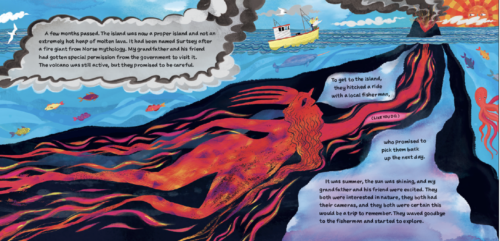
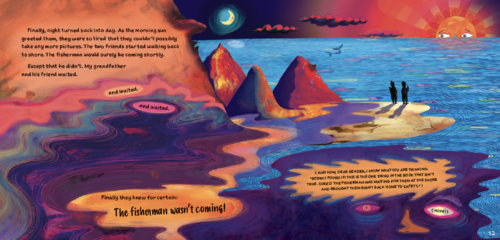
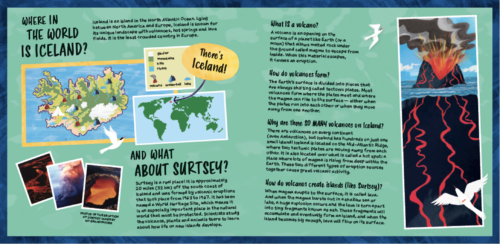
Almost all the facts in this book are true. Can you find the single lie? When the author’s grandfather got stranded on an active volcanic island with this friend their survival was NOT guaranteed. An unexpectedly hilarious and harrowing tale. Kooky little bit of writing, but I think it’s that kookiness that makes it work. First and foremost, this is really very funny. I think that there’s a lot to be said for authors writing stories about their grandparents’ stupid stupid decisions. About the point the glasses have melted, you are ON BOARD with this book. And the fact that you just happen to learn a lot about volcanoes and Iceland (and I’m grateful for now always knowing how to pronounce “Ævar”) is just the icing on the cake. A delightful read! Previously Seen On: The Science and Nature List
There Was a Party for Langston, King of Letters by Jason Reynolds, ill. Jerome Pumphrey & Jarrett Pumphrey
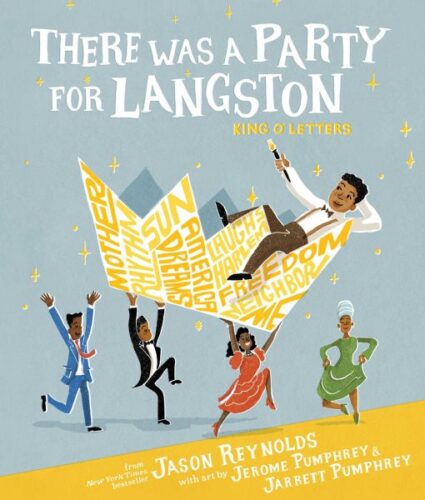

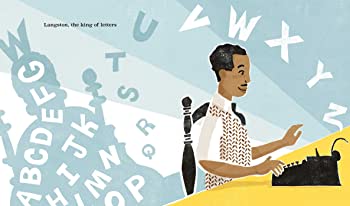
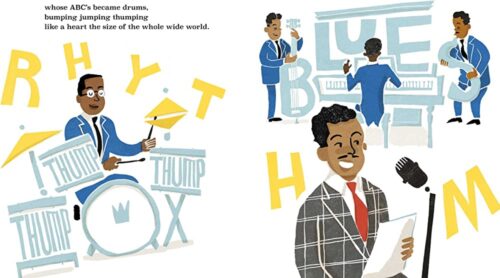
“There was a party for Langston at the library” Langston Hughes, that is. A marvelous recounting of one man’s legacy and a vibrant visual praise of Black American writers. This text sings. Oh, happy day! I like this book by the Pumphreys! I like this book by the Pumphreys so much that I honestly think that this book has some serious Caldecott contender cache surrounding it. Woohoo! This is a marvelous example of how a good writer (and they don’t get much better than Jason Reynolds) can do a bit of nonfiction without faking anything AND making it a fun read for kids! Gone are the rote bios that dully recount a person’s life without viv or flair. And the typography! I hope someone interviews the Pumphreys and Jason together so that we can hear about how this collaboration actually occurred. How much influence did he have over their art? Was it their idea to turn the first names of Maya Angelou and Amiri Baraka (I’m assuming that’s the Amiri Jason means) into their bodies? Bonus: 500 extra points to Jason Reynolds for the line, “rickety radio heart”. Previously Seen On: The American History List
To See Clearly: A Portrait of David Hockney by Evan Turk
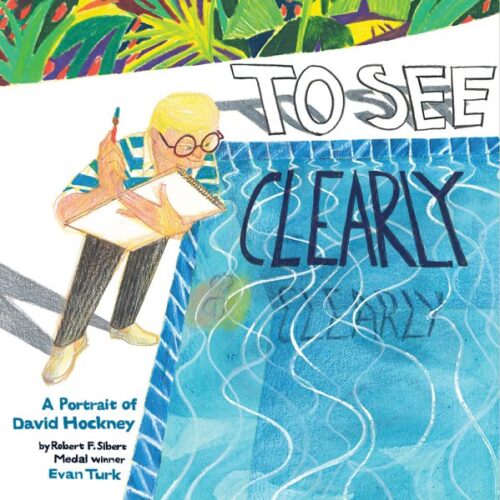
We’re doing the whole artist telling the story of an artist thing again, but I don’t think I would have predicted Turk doing Hockney on my own. After all, they’ve rather different styles when you think about it. Turk has illustrated bios of different artists before, but the last time he did one on Ben Shahn he wasn’t the author. Turns out, the man is quite good at synthesizing a life into a picture book format. Turk isn’t trying to replicate Hockney’s style with this book (a technique that has served some biographer illustrators well but that isn’t a strict requirement). Instead he pulls out his customary colored pencils, gouache, and crayons and goes to town on the whole enterprise. One cannot help but wonder if Hockney will ever see the book himself and, if so, what he’ll think of it. But you know what? Who cares! It’s a dang good biography, making his life not merely pertinent to young readers but interesting as well. Extra points for not eliding over his life as a gay man but for leaning into it as an essential part of his being. Great, grand, and beautiful. Previously Seen On: The Biography List
Tomfoolery! Randolph Caldecott and the Rambunctious Coming-of-Age of Children’s Books by Michelle Markel, ill. Barbara McClintock

Meet Randolph Caldecott! The children’s book illustrator unafraid to put fun, action, and loads of animals on the page. A marvelous look at the artist our picture books owe so much to today. Both Markel and McClintock are having a lot of fun with this subject. What they both do so well is stress this change from the solid, staid, stultifying children’s books that preceded Caldecott and what he brought to the form. It never cheats, and yet still manages to have so much fun. Extra points to McClintock for including actual shots of early dull titles (“In Adam’s fall / We Sinned all” and all that). I don’t know that I’ve ever seen her integrate mixed media like this into her art, but she’s a natural. I’m always so happy when she does nonfiction. She’s like a breath of fresh air to the page. And be sure to check out the two-page spread where she’s included a lot of contemporary Caldecott winners (I needed help with the two on the far left, but I know them now). An amazing ode that actually ends up being a really good book of its own. Not easy! Previously Seen On: The Biography List
We Are Human Animals by Rosie Haine

What were the early human animals like? What was their world? A beautiful look at what we have in common with our ancestors, where we differ, and how we are all, still, animals. When I was a kid I remember watching this brief section of Sesame Street that was going through different animals. At the end, it shows a group of people at a picnic or something and declares that we are “human animals”. This shocked my tiny little mind. Until that moment, I was fairly certain that humans were something above animals. Not many books really explore this idea, so I was intrigued by this title alone. Inside it’s a particularly nice simplified encapsulation of early humanity. The text is so sparse and spare and good. Then you get to the incredible backmatter, which is lovely but this isn’t one of those cases where the stuff in the back eclipses the quality of the stuff in the front. I adore how much research Rosie Haine has done here. This is just really cool.
We Go Way Back by Idan Ben-Barak, ill. Philip Bunting
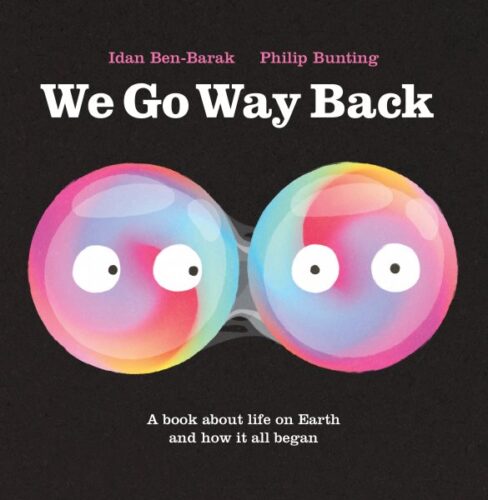
What is life? Where did you get yours from? And how did it all start? A funny but accurate look at the beginnings of life, from atoms and elements to the creatures we have today. You know how sometimes rock stars form supergroups together? I feel like picture book authors and illustrators sometimes do the same thing. This book’s a good example of that. You have Idan Ben-Barak, who was one of the authors of Do Not Lick This Book and then you have Philip Bunting who’s behind the aforementioned The Gentle Genius of Trees, together for a story about how life began. And believe me, I’ve read a lot of books on the subject, but this is the first I’ve seen to show the elements forming the molecules and the molecules forming the bubbles that became cells. I love how visual this is! Bunting should get extra credit for that family tree fold-out section. Examine it for a while, if you can. He had to make a lot of distinct choices there. And, as is right, I love the googly eyes on everything. Everything is better with googly eyes. Previously Seen On: The Science and Nature List
What Music! The Fifty-Year Friendship Between Beethoven and Nannette Streicher, Who Built His Pianos by Laurie Lawlor, ill. Becca Stadtlander
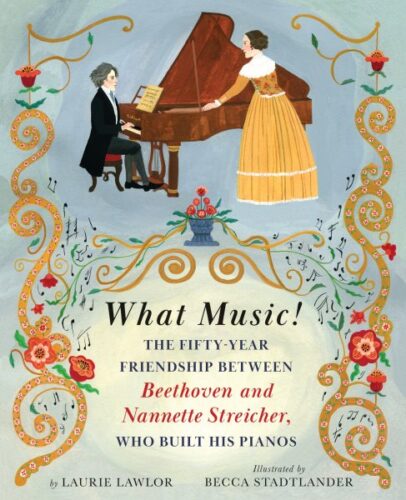
Who the heck says women and men can’t be friends? Now that title, I’ll be the first to admit, is a bit of a mouthful, but ultimately I think Holiday House made the right choice with it. After all, what it does is establish that Nannette Streicher was, almost impossibly, a business woman at a time when that wasn’t really a thing. And let me tell you, after reading countless books about women like Mozart’s sister, who were brilliant but ultimately thwarted, there’s something so deeply satisfying about learning Nannette’s story. Evanston-based author Lawlor herself had to do a slew of original research to get to the gist of this story. As she explains it, “I was inspired to investigate the friendship between Ludwig and Nannette when I discovered more than 60 letters and notes penned between 1817 and 1818. These were all addressed to Nannette. None of her replies survived.” So she dug in and discovered that Nannette tweaked, improved, built, and sold pianos. She managed a family, a business, and designed and refined instruments. But is it actually fun for kids to read? Well, actually, yes. Lawlor cleverly figured out that the heart of this story is Beethoven and Nannette’s relationship. They just really do come off like buddies (and we all know how difficult he was as a person to know). Love the amount of work that Lawlor clearly poured into this book. A great female entrepreneur book and music title AND friendship book all in one. Previously On: The Biography List
What’s Inside a Caterpillar Cocoon? And Other Questions About Moths and Butterflies by Rachel Ignotofsky
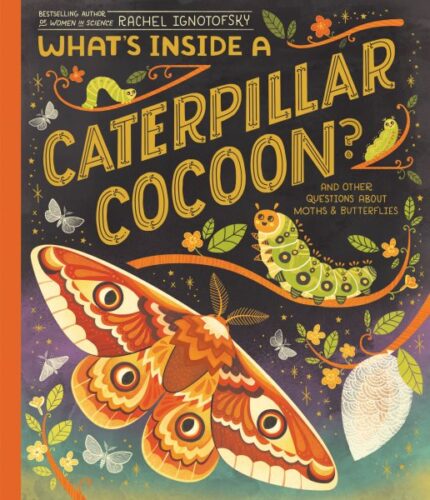
How are moths and butterflies related? What goes on in a cocoon or chrysalis? Immerse yourself in this gorgeous and informative deep dive into what makes these creatures some of the most fascinating in the world. Beautiful books have burned me before, so I didn’t necessarily trust this book when I first encountered it. I mean, sure, its cover glows with pretty gold foil and the art inside is nothing short of amazing, but usually this kind of book has huge chunks of immovable text that is so hard for a kid to want to read, unless they’re friggin’ obsessed with the subject matter. But this book? The perfect amount of text! What’s more, a very systematic and informative series of pages about the differences between moths and butterflies. That art really is as beautiful, as I mentioned before, and then at the end you get a small bibliography of sources, and resources for kids to help butterflies and moths on their own. It’s informative and, best of all, has a lot to say about helping the Earth. I kinda love it. Previously Seen On: The Science and Nature List
When Moon Became Moon by Rob Hodgson
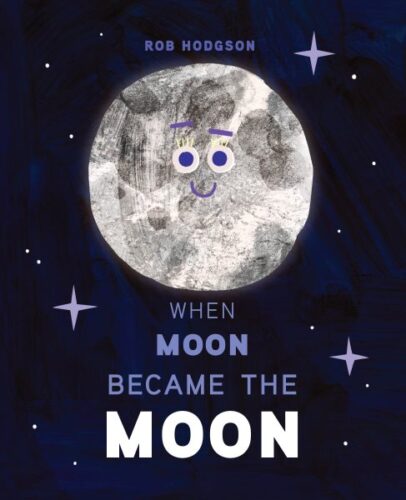
As he did for clouds, so too shall he do for the moon. Rob Hodgson first appeared on my radar when he created the greatest water cycle picture book of all time, When Cloud Became a Cloud. He just has this way of turning complicated science concepts into ideas so simple a young elementary school reader can understand them. With his sights now resting entirely on the skies, Rob does something right at the start of this book that I really appreciated. He manages to show how the moon formed in a concrete and understandable way. First, he shows how Earth crashed into “another early planet”. The rocks that came out of this zoom around her gravity. Then, “Some of the rocks were so excited to be together that they got closer and closer, and hotter and hotter, until… They came together to form a moon.” This is shown so simply and clearly and I really appreciated its inclusion (other books on this subject sometimes elide this part of the process or skip over it entirely). I also appreciated that throughout all of this, the Earth is not depicted as blue or anything. You’d be amazed how many books discussing early Earth do this. The rest of the book covers the tides, keeping the Earth steady, seasons, eclipses, you name it. If you could have only one book for younger kids on the moon, I think you’d want it to be this one. Previously Seen On: The Science and Nature List
A Year of Good News by Martin Smatana
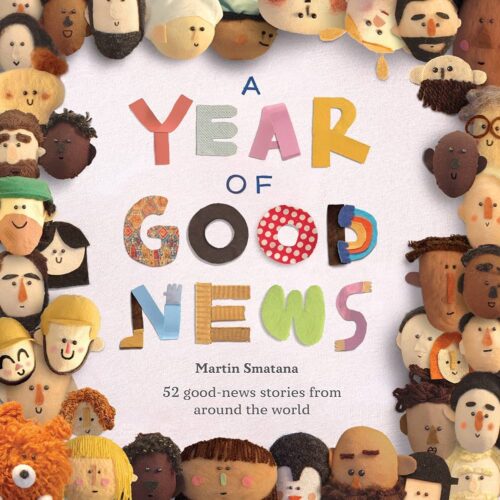
Need a pick-me-up? During the first year of the pandemic, artist Martin Smatana started illustrating one piece of good news every week. Now his creations are a book. Like a hug for your eyeballs. Admittedly, there is something awfully relaxing about this book. It’s quick, to the point, and cheery. The standout here is the art, though. Without it, the book might feel more like a page-a-day calendar than anything else. It is funny to read Martin Smatana say “I’m not very good at drawing” only to create these remarkable images with mixed media. Some of these have an amazing sense of depth to them. It makes for an oddly good companion to this year’s Desert Jungle by Jeannie Baker. Very cool.
You and the Bowerbird by Maria Gianferrari, ill. Maris Wicks
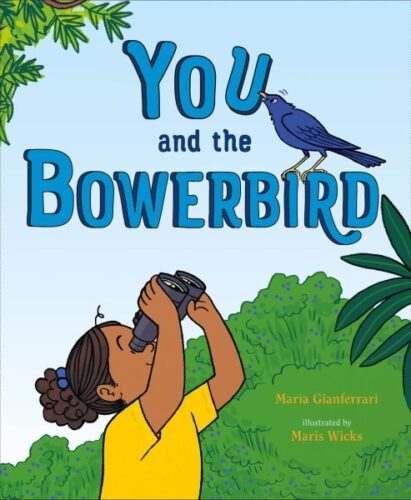
What bird designs its bower with objects that are a favorite shade of blue? The bowerbird, of course! Watch it design, arrange, and defend its creation, all in the name of love. I’ve been a huge fan of Maris Wicks since I first stumbled on her independently published picture book comic Yes, Let’s more than a decade ago back in NYC at MOCCA. She’s done a lot since then, but pairing with Gianferrari is not the career move I would have predicted. Gianferrari is usually writing alongside the hyper-realistic Bagram Ibatoulline types. Still, Wicks’ silly, almost cartoonist, style is a perfect accompaniment for this explanation of how bowerbirds design their bowers. I like it when nature gets silly on me. This book is silly, and then some! Previously Seen On: The Science and Nature List
Yukie’s Island: My Family’s World War II Story by Yukie Kimura, Kōdo Kimura and Steve Sheinkin, ill. Kōdo Kimura

Imagine having a whole island to yourself! Yukie collects seagull eggs, explores caves, and loves her father’s lighthouse, but when war comes to her island, she and her family must make it through together. I’m seeing a plethora of nonfiction titles by authors about their grandparents (I read this and the aforementioned Stranded! in the same sitting). I love how the information in this particular book was laid out, as well as some of the phrasings from scene to scene. For example, “Time is slow when you’re waiting. Even for something bad.” Or when Yukie’s father is playing his flute. “The music sounded like things he was afraid to say,” and later, “The music sounded like things I wished I didn’t know.” An honest portrait of wartime Japan does feel filled with authenticity but is not so harsh that it’s going to traumatize kids. And hard to believe that this is Kimura’s first picture book! Excellent art and a great story that really leans into the fun of the island as well as the important war bits.
Hope you enjoyed these! Here are the lists you can expect for the rest of this month:
December 1 – Great Board Books
December 2 – Picture Book Readaloud
December 3 – Simple Picture Book Texts
December 4 – Transcendent Holiday Picture Books
December 5 – Rhyming Picture Books
December 6 – Funny Picture Books
December 7 – CaldeNotts
December 8 – Picture Book Reprints
December 9 – Math Books for Kids
December 10 – Gross Books
December 11 – Books with a Message
December 12 – Fabulous Photography
December 13 – Translated Picture Books
December 14 – Fairy Tales / Folktales / Religious Tales
December 15 – Wordless Picture Books
December 16 – Poetry Books
December 17 – Unconventional Children’s Books
December 18 – Easy Books & Early Chapter Books
December 19 – Older Funny Books
December 20 – Science Fiction Books
December 21 – Fantasy Books
December 22 – Comics & Graphic Novels
December 23 – Informational Fiction
December 24 – American History
December 25 – Science & Nature Books
December 26 – Unique Biographies
December 27 – Nonfiction Picture Books
December 28 – Nonfiction Books for Older Readers
December 29 – Audiobooks for Kids
December 30 – Middle Grade Novels
December 31 – Picture Books
Filed under: 31 Days 31 Lists, Best Books, Best Books of 2023
About Betsy Bird
Betsy Bird is currently the Collection Development Manager of the Evanston Public Library system and a former Materials Specialist for New York Public Library. She has served on Newbery, written for Horn Book, and has done other lovely little things that she'd love to tell you about but that she's sure you'd find more interesting to hear of in person. Her opinions are her own and do not reflect those of EPL, SLJ, or any of the other acronyms you might be able to name. Follow her on Twitter: @fuseeight.
ADVERTISEMENT
ADVERTISEMENT
SLJ Blog Network
One Star Review, Guess Who? (#211)
Kevin McCloskey on ‘Lefty’ | Review and Drawn Response
Notable NON-Newbery Winners: Waiting for Gold?
The Seven Bills That Will Safeguard the Future of School Librarianship
Take Five: Newbery Picks, Part Two
Gayle Forman Visits The Yarn!
ADVERTISEMENT



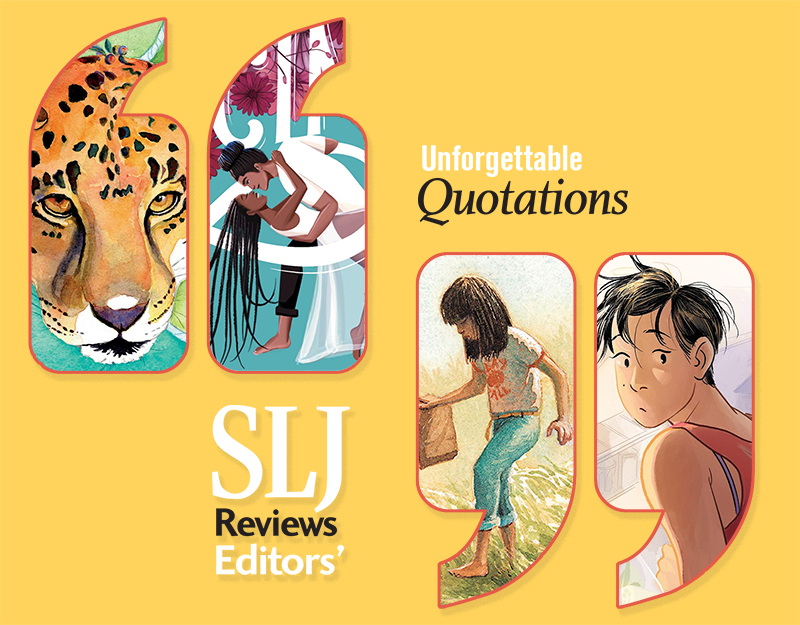
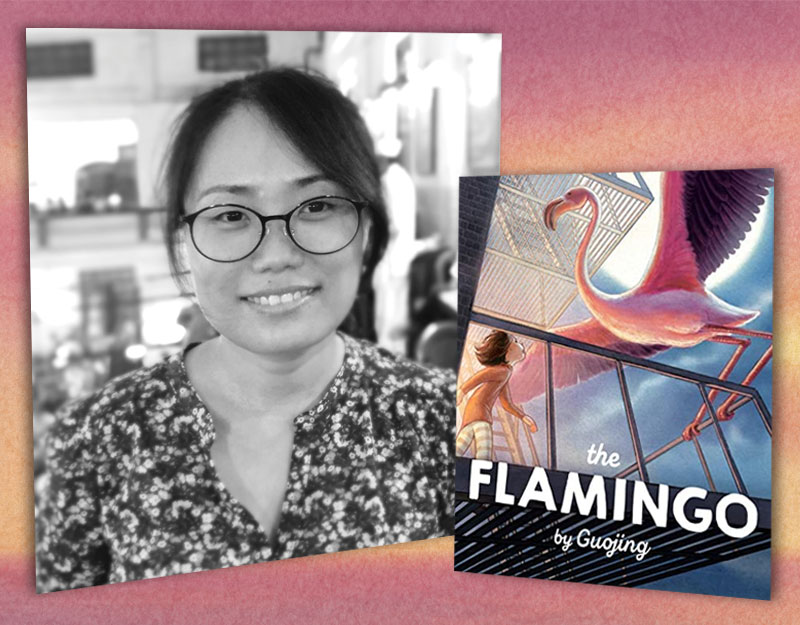
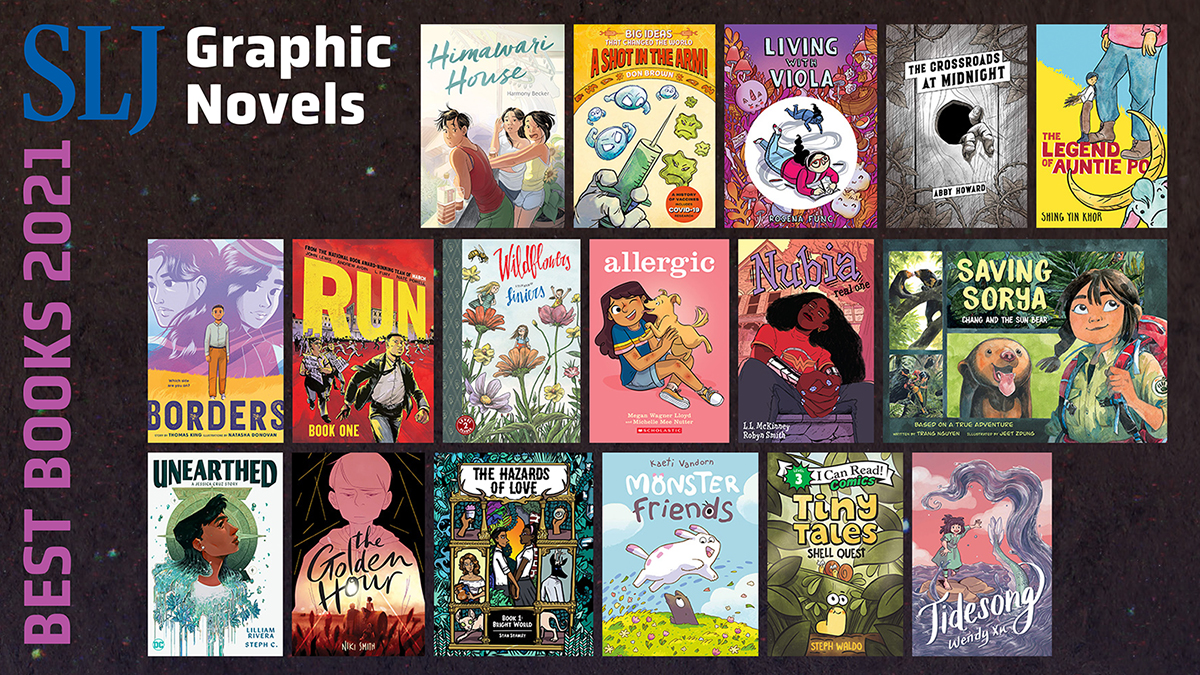

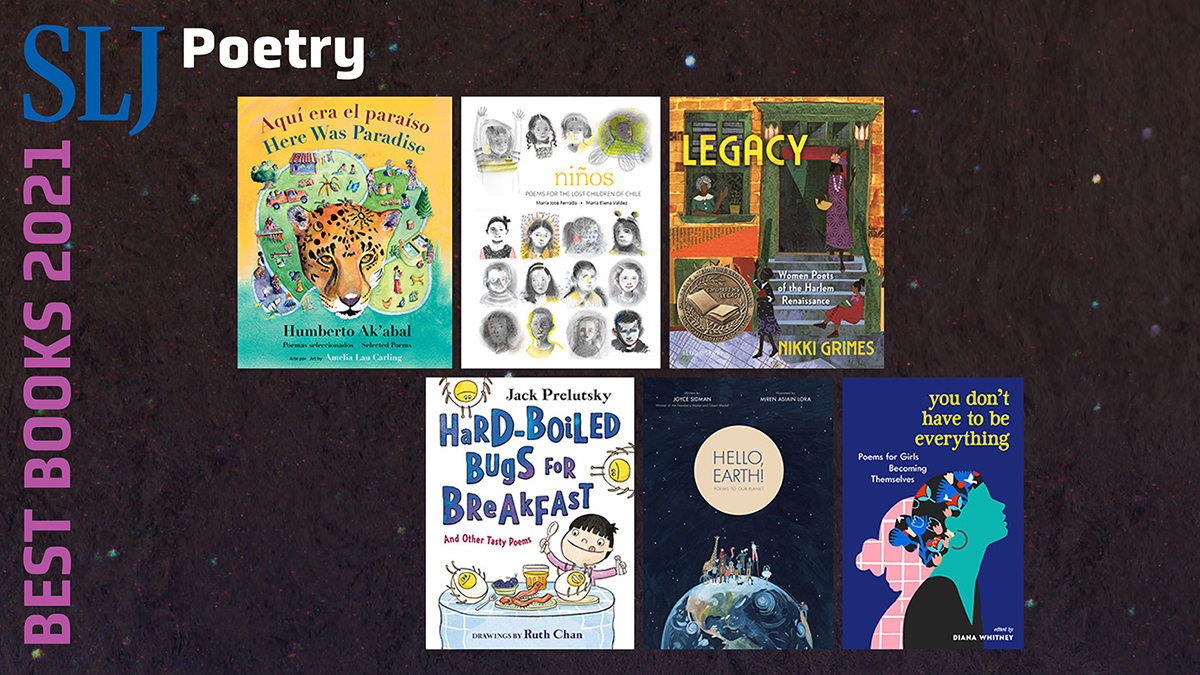
Another fantastic list! Thank you for sharing these titles.
Jumper and the Bees of Notre Dame are in my canon of books I absolutely LOVE!
So happy to see Desert Queen here – again. Wow, gobsmacked.
This is a super list of nonfiction picture books! Thank you for sharing.
I have a friend who paid special bee experts much money to remove a hive from her backyard and RELOCATE the insects to a safe environment. I love to give her bee-related gifts. THE BEES OF NOTRE DAME will be a perfect gift. I’m also interested in reading STARS OF THE NIGHTT and A YEAR OF GOOD NEWS.
“Nicky & Vera: A Quiet Hero of the Holocaust and the Children He Rescued” by Peter Sís may be the Nicholas Winston picture book you were thinking of. It got a lot of attention when it it came out a couple of years ago.
That’s the one!!